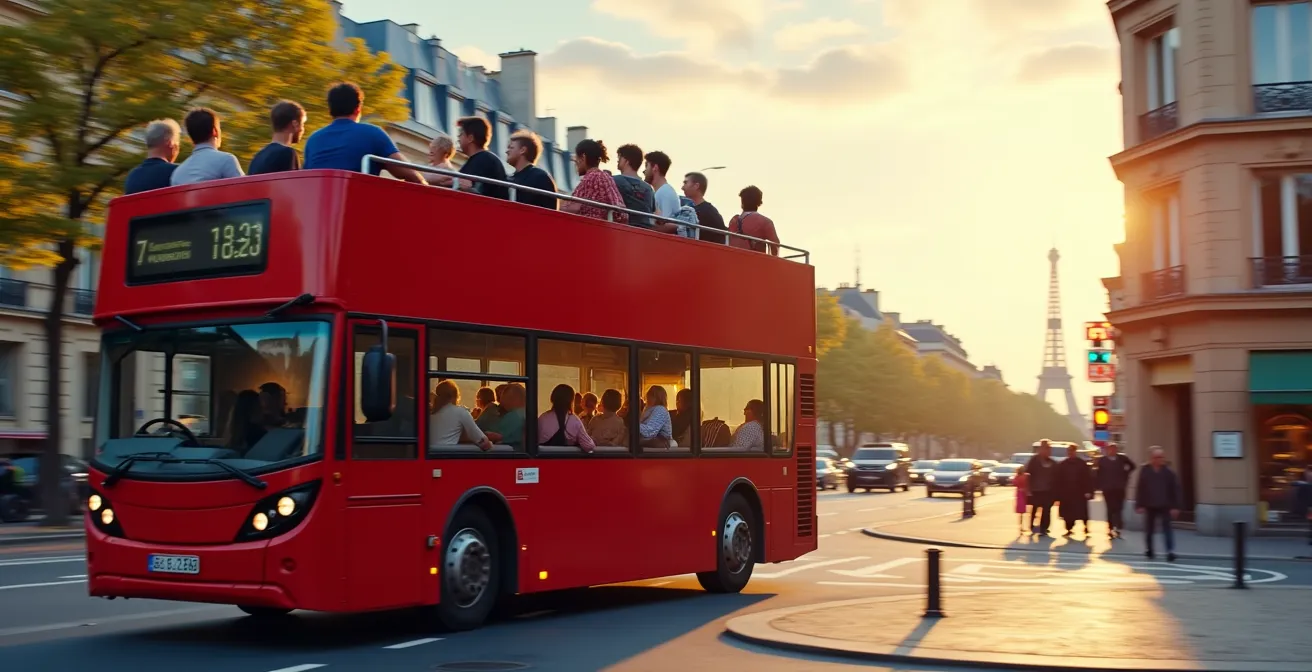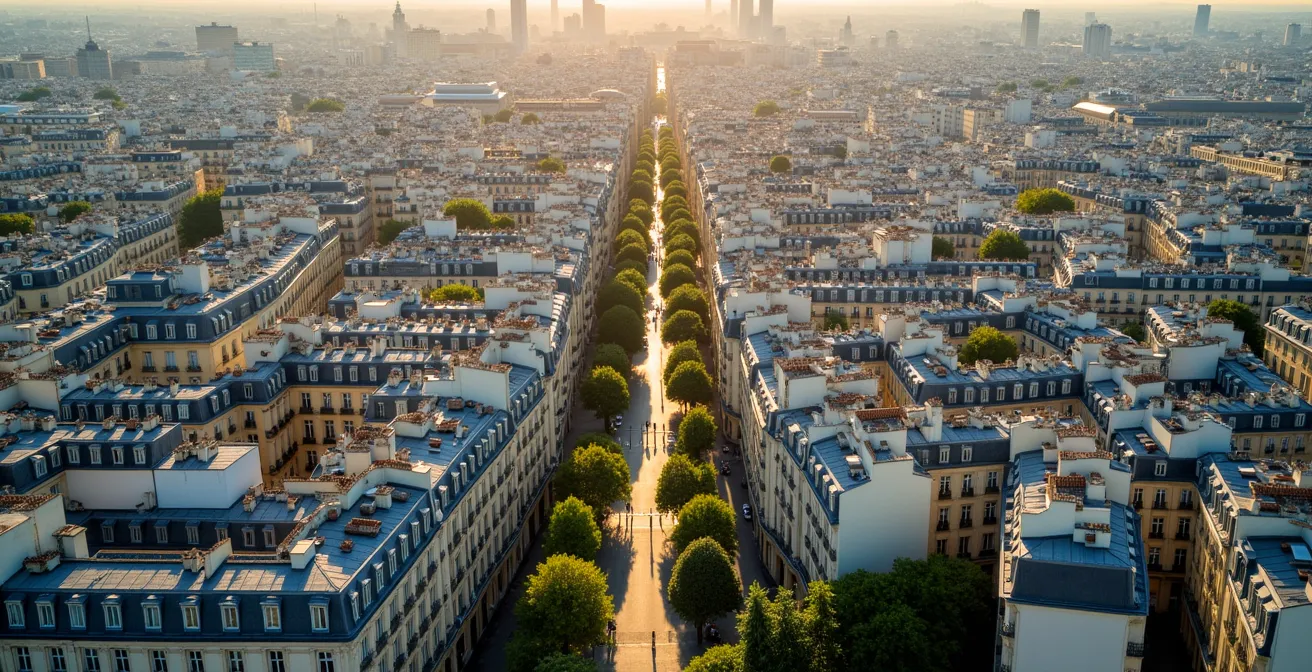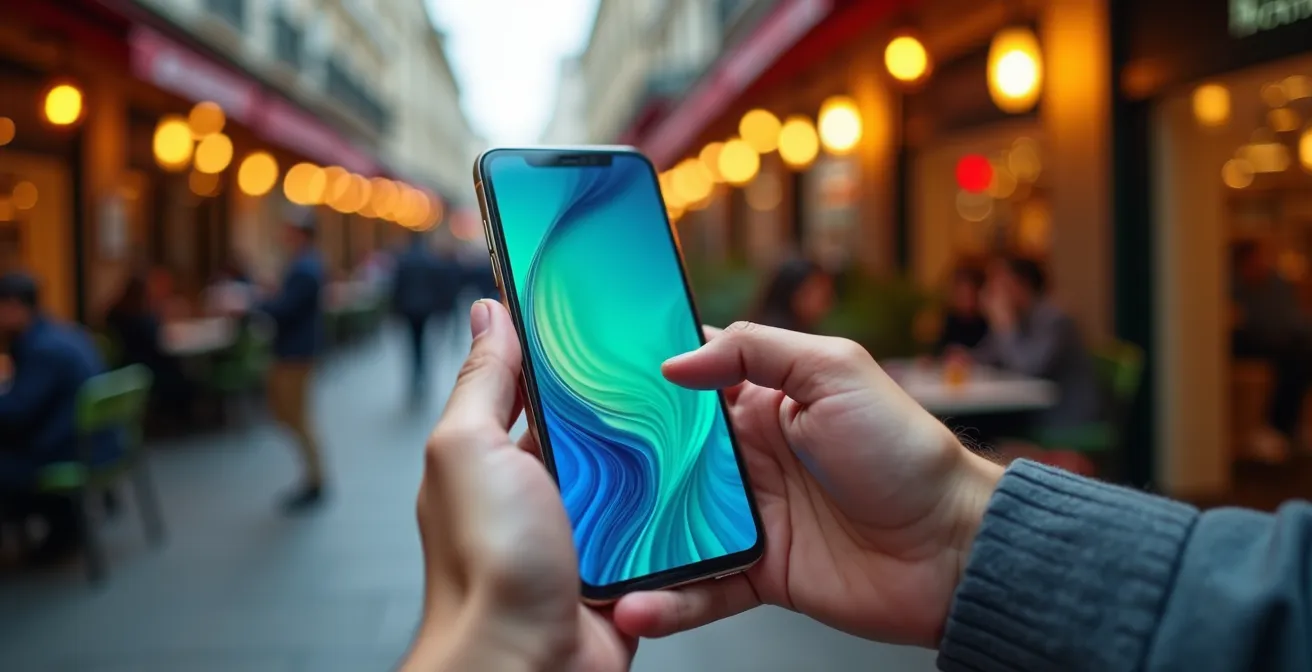
The double-decker bus, a familiar sight in the world’s greatest cities, is often dismissed as a passive, postcard-skimming experience. But to see it merely as a vehicle for sightseeing is to miss its true potential. A hop on hop off Paris tour is not just a ride; it’s a powerful logistical framework. When leveraged with intent, it transforms from a simple tour into a strategic tool for deconstructing the city, unlocking efficient travel between iconic landmarks and, more importantly, serving as a gateway to authentic neighborhood immersion.
This approach moves beyond simply seeing the Eiffel Tower or the Louvre from a top deck. It’s about using the bus network as a master key to the city’s intricate layout. By understanding route dynamics, operator nuances, and digital tools, you can craft a personalized and deeply rewarding Parisian adventure that combines world-famous sites with the hidden charm of local life. It’s time to view the bus not as the destination, but as the smartest start to your real exploration.
Your Paris Bus Tour Strategy in 4 Steps
- Plan Strategically: Don’t just ride. Use the bus map to align your must-see attractions with specific routes and stops.
- Think Beyond Landmarks: Use bus stops as springboards to dive deep into the unique character of Parisian arrondissements.
- Choose Your Operator Wisely: Compare factors like eco-friendliness, route coverage, and tech features to find your perfect match.
- Leverage Technology: Maximize your time with operator apps for real-time bus tracking, offline maps, and audio guides.
Deconstructing Paris: Crafting your strategic hop-on hop-off itinerary
True mastery of a hop-on hop-off tour lies in treating it not as a passive circuit, but as an active transit system tailored to your interests. The first step is to move from a tourist mindset to that of a strategist. Map out your personal “must-see” list—from the grand halls of the Louvre to a specific pâtisserie in the Latin Quarter—and overlay it onto the bus routes. This reveals logical sequences and minimizes backtracking, turning a sprawling city into a manageable puzzle.
Timing is a critical layer of this strategy. Understanding the rhythm of the city can dramatically enhance your experience. Boarding the first bus of the day allows you to experience the initial loop in relative tranquility, while avoiding peak attraction hours can save you from the longest queues. For instance, planning a museum visit for later in the afternoon when crowds often thin out can be a savvy move. The initial “full loop” is an invaluable reconnaissance mission. Use this uninterrupted circuit to get your bearings, listen to the overview commentary, and make informed decisions about where you’ll invest your time hopping off.
Strategic route planning checklist
- Start with the full circuit tour (2 hours 15 minutes) to get oriented with major landmarks
- Identify priority stops based on your interests and time constraints using the interactive map
- Plan visits during off-peak hours – avoid 11 AM-2 PM and 4-6 PM for shorter wait times
- Use first bus departure at 9:45 AM for less crowded initial experience
- Coordinate with Metro connections at major stops for seamless city exploration
Finally, the most efficient exploration seamlessly integrates the tour bus with Paris’s other transport arteries. With an extensive public transport network where 4,490 buses and 12,876 drivers serve more than 12,500 physical bus stops across 347 bus lines, the city is designed for multi-modal travel. Use the bus for scenic, medium-to-long distances between neighborhoods, then switch to the Métro for rapid cross-city jumps or simply walk to soak in the details of a specific arrondissement.
Optimized Paris discovery itinerary example
A successful 2-day Paris strategy involves starting with Tootbus Discovery route covering 10 essential stops including Opera, Louvre, Notre-Dame, and Eiffel Tower. The route operates every 10-15 minutes with electric buses providing panoramic views. Visitors can complete the full 2-hour circuit first, then strategically hop off at Trocadéro for Eiffel Tower photos, Louvre for museum entry, and Champs-Élysées for shopping, maximizing both sightseeing and specific attraction visits.
Understanding the operational specifics of each service is key to this planning. Below is a comparison of typical frequencies and timings for major operators.
| Operator | Bus Frequency | First Departure | Last Departure | Full Circuit Duration |
|---|---|---|---|---|
| Big Bus Tours | 7-11 minutes | 9:45 AM | 5:30 PM | 2 hours 15 minutes |
| Tootbus | 10-15 minutes | 9:30 AM | 6:30 PM | 2 hours |
| Batobus (River) | 30 minutes | 10:00 AM | 7:00 PM | 2 hours |
Beyond the postcards: Discovering parisian neighborhoods with your bus pass
The true magic of Paris reveals itself not just at the base of its monuments, but in the lively streets of its diverse arrondissements. A hop-on hop-off bus pass is your springboard into this authentic local life. The key is to identify the “gem stops”—those located at the nexus of distinct neighborhoods, allowing for deeper exploration beyond the main attraction they serve.
Which are the best bus stops for neighborhood exploration?
The Notre-Dame stop is a perfect gateway to both the historic Île de la Cité and the vibrant Latin Quarter. Similarly, the Musée d’Orsay stop puts you on the doorstep of the chic Saint-Germain-des-Prés, while the Opera stop opens up the charming 9th arrondissement.
Use the bus to efficiently cover the distance to a target arrondissement, then hop off and dedicate your time to a focused walking tour. As noted in guides to the city’s districts, the experience shifts dramatically from one area to the next. The 3rd arrondissement’s quiet residential streets offer a stark contrast to the bustling 4th, while the 11th provides a taste of authentic nightlife away from the main tourist circuits. The bus gets you to the edge of these worlds; it’s up to you to step inside.

Don’t neglect the “in-between” spaces. Often, the most memorable discoveries are made in the blocks between major bus stops. A short walk can lead you to a hidden courtyard, a local market, or a family-run boulangerie. This is where the strategic value of the tour shines: it provides the macro-framework, giving you the freedom to create your own micro-adventures within it. The table below highlights how key stops provide excellent access to rich cultural experiences.
| Bus Stop | Neighborhood Access | Cultural Attractions | Local Experience Rating |
|---|---|---|---|
| Opera Garnier | 9th Arrondissement | Palais Garnier, Grand Boulevards | 8/10 |
| Louvre Museum | 1st Arrondissement | Palais Royal, Tuileries | 9/10 |
| Notre-Dame | 4th Arrondissement | Latin Quarter, Île de la Cité | 10/10 |
| Champs-Élysées | 8th Arrondissement | Fashion district, luxury shopping | 7/10 |
Operator deep dive: Choosing your ideal Parisian bus companion
While many hop-on hop-off services may seem similar on the surface, a closer look reveals key differences that can significantly shape your Parisian experience. Factors range from the physical routes and fleet technology to the quality of the audio commentary. A direct comparison is essential for aligning an operator with your travel priorities, whether they be sustainability, technological convenience, or route comprehensiveness.
Tootbus, for instance, distinguishes itself with a commitment to sustainability, operating a fleet of 100% electric buses and offering advanced digital features like real-time tracking through its app. Big Bus Tours provides a classic experience, often praised for its frequency and live guide options on certain tours. Your choice depends on what you value most: the eco-conscious, tech-forward approach or the traditional, guide-led tour.
| Feature | Big Bus Tours | Tootbus Paris | Key Differences |
|---|---|---|---|
| Fleet Type | Classic double-decker | 100% electric buses | Tootbus more eco-friendly |
| Audio Languages | 8 languages | 10 languages + kids channel | Tootbus broader coverage |
| Route Coverage | 10 stops, 12 attractions | 10 stops, 19 attractions | Tootbus more comprehensive |
| Technology | Pre-recorded commentary | AI guide + real-time tracking | Tootbus more advanced |
| Sustainability | Conventional buses | Electric + solar charging | Tootbus leading sustainability |
The push for sustainability is becoming a significant differentiator in urban tourism. Companies are not just providing a service but are also making a statement about their environmental responsibility. Tootbus’s approach is a prime example of this evolution in the industry.
Tootbus solidifies its position as a leader in low-emission urban tourism with comprehensive sustainability strategy involving repowering existing buses and introducing new electric buses. The company pledges to achieve net-zero emissions by 2030 and operates as the world’s first low emission sightseeing bus company.
– RATP Dev Communications, RATP Dev Official Press Release
This commitment is backed by tangible action. For example, a significant portion of the Tootbus fleet is already electric, with studies showing that 35% of Tootbus fleet is electric vehicles, producing 5 times less emissions than conventional diesel operators. This focus on green technology demonstrates a forward-thinking approach that resonates with many modern travelers.
Tootbus sustainability innovation implementation
Tootbus partnered with VEV to develop end-to-end sustainability solutions, installing roof-mounted solar panels at their Wandsworth depot capable of generating 66,000 kWh annually. This innovative approach powers 60,000km of travel per year with clean energy – an industry first. The initiative forecasts carbon-emissions savings of 15,567kg per year and demonstrates how sightseeing companies can achieve genuine environmental impact while maintaining service quality.
Key takeaways
- Shift your mindset from passive tourist to active strategist to truly master the hop-on hop-off experience.
- Use bus stops not as endpoints, but as strategic gateways for deeper exploration of Parisian neighborhoods.
- Compare operators based on sustainability, technology, and route details to perfectly match your travel style.
- Leverage operator mobile apps for real-time tracking and audio guides to maximize efficiency and enrichment.
The savvy traveler’s toolkit: Unlocking the full potential of your bus tour
In today’s travel landscape, the most valuable tool in your pocket is your smartphone. Leading bus tour operators have invested heavily in digital platforms that transform the sightseeing experience from a static route to an interactive journey. Leveraging these tools is no longer an option but a core component of a savvy travel strategy for exploring Paris with a bus tour. Downloading the operator’s app before you even arrive is the first step toward a seamless day.
These apps provide mission-critical information like real-time bus tracking, which eliminates guesswork and minimizes wait times. You can also pre-load audio commentary, access offline maps, and even discover curated walking tours that begin right where you hop off. Actively engaging with the audio guide can transform a simple ride into a rolling history lesson, offering context and stories that bring the city’s stone facades to life.

Beyond navigation, these digital tools serve as a concierge, pointing you toward nearby amenities, local eateries, and smaller attractions that might otherwise go unnoticed. By embracing these resources, you extend the value of your ticket far beyond the ride itself, turning it into a comprehensive city guide that adapts to your location and interests in real time.
Maximizing your mobile app
- Download the Tootbus app before departure to access offline maps and route planning features
- Enable real-time bus tracking and geolocation services for accurate arrival predictions
- Pre-load audio commentary in your preferred language to avoid connectivity issues
- Use the app’s walking tour suggestions to enhance stops with guided neighborhood exploration
- Access exclusive app-only content and personalized recommendations based on your interests
- Book tickets securely through the app for seamless mobile scanning and boarding
The Tootbus app enhances the Paris hop-on hop-off experience significantly. You can download it to track buses, play audio guides as desired, and access additional walking tour routes with accompanying audio guides. Since this company operates as a branch of the Paris public transit system, almost all stops are next to public bus stops, making integration with city transportation seamless for extended exploration.
– La Mour de Paris, lamourdeparis.com
The quality of the audio guide can make a significant difference in your tour. Some offer deep historical dives, while others focus on cultural anecdotes. Comparing these features can help you choose the experience that best fits your interests. After a full day of strategic sightseeing, you might want to relax and Get the most from a spa experience to recharge for your next Parisian adventure.
| Audio Feature | Big Bus Tours | Tootbus Paris | Quality Rating |
|---|---|---|---|
| Commentary Depth | Historical focus | Cultural + historical | Tootbus: 8/10, Big Bus: 7/10 |
| Language Options | 8 languages | 10 languages + kids | Tootbus superior coverage |
| Technical Quality | Pre-recorded standard | AI-enhanced + live updates | Tootbus more advanced |
| Timing Accuracy | Sometimes delayed | Real-time synchronization | Tootbus better coordination |
Frequently asked questions on Paris travel guide
Which neighborhoods are best accessed via hop-on hop-off stops?
The Marais (via Notre-Dame stop), Latin Quarter (via Notre-Dame), Saint-Germain-des-Prés (via Musée d’Orsay stop), and Montmartre (via dedicated routes) offer the richest local experiences within walking distance of bus stops.
How do I use bus stops to explore authentic Parisian life?
Exit at less obvious stops like Alexandre III Bridge-Invalides to explore the 7th arrondissement’s residential streets, or use the Opera stop to discover the charming 9th arrondissement’s passages and local cafés.
Can I combine bus tours with local public transport?
Yes, most Tootbus stops are strategically located next to public bus stops and Metro stations, allowing seamless integration with Paris’s public transportation system for deeper neighborhood exploration.